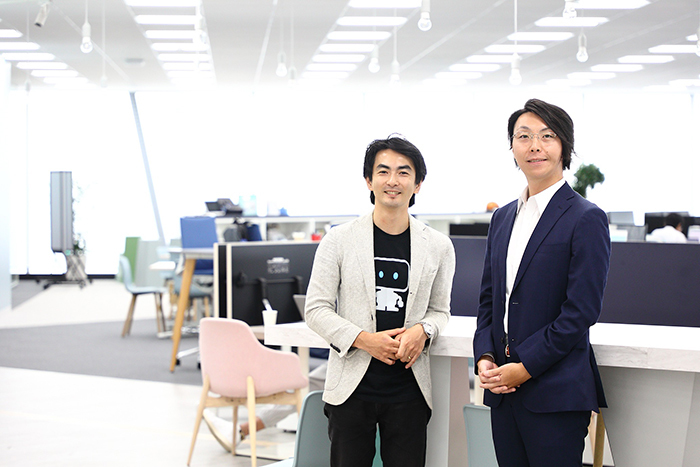The People Driven Marketing (PDM) framework, an integrated marketing approach centered on "people" promoted by the Dentsu Group, is evolving. It has progressed from PDM 2.0, which focused on people's "awareness" and "behavior," to the newly launched PDM 3.0 this fall. This time, we spoke with Akira Shibata, Chief Data Scientist at the AI platform DataRobot, and Shinichi Toku, Manager of the Digital Innovation Group at Dentsu Digital Inc., about the value that data and AI bring to companies engaged in marketing and, ultimately, to consumers.
The Growing Importance of AI and Machine Learning in Marketing
── AI adoption is expanding, but how is it useful in the marketing domain?
Shibata: AI and machine learning are technologies that help predict outcomes in domains with large amounts of data. Marketing is one such domain because it has the need to predict human behavior.

Chief Data Scientist at DataRobot, PhD in Physics
Specializes in creating business value through AI-driven data analysis. Currently serves as Japan Market Technical Lead at DataRobot (https://datarobot.com), headquartered in Boston and home to many of the world's top data scientists. Contributed to the discovery of the Higgs boson, the "God particle," by building statistical models for accelerator data during his time as a researcher at NYU. Subsequently worked as a consultant at Boston Consulting Group. Served as Founder & CEO of Shiroyagi Corporation, provider of the news curation app "Camellio," before assuming his current role.
Beneficial: Machine learning began being utilized in marketing and advertising around 2010. It started being used for automated bidding in digital advertising and some text auto-generation.
Later, as smartphones became ubiquitous, customer touchpoints multiplied, leading to an exponential increase in collected data.
Recognizing human behavior patterns and optimizing ad delivery and customer management became too much for marketers to handle manually alone, driving the growing need for machine learning.

Manager, Digital Innovation Group, Data/Technology Division, Dentsu Digital Inc.
After working in M&A due diligence, strategic planning centered on data marketing, business development, and marketing consulting, he assumed his current role. His strength lies in integrating cutting-edge marketing technologies like AI (machine learning), MA, CRM, DMP, and BI to solve management and business challenges. He also excels at discovering and forming alliances with the latest digital tools globally, and has given numerous lectures and authored many articles on digital marketing.
Shibata: Marketers often feel compelled to accumulate as much data as possible, thinking, "If machine learning can automatically process it, then even volumes impossible for humans to handle are manageable."
However, in reality, larger data volumes don't necessarily equate to superior quality.
Valuable data is
Shibata: A single company can only capture a very small part of the broad spectrum of human behavior. For example, you might know what a customer bought at your store, but you can't see the entire contents of their wallet.
But what marketing really wants to know is the breakdown of what's inside that wallet.
Beneficial: Exactly. Suppose a customer has 10,000 yen in their wallet, spends only 1,000 yen at your store, and spends the remaining 9,000 yen elsewhere. It's difficult to grasp the full picture of their spending habits based solely on that 1,000 yen.
From a marketing perspective, that could lead to misinterpretation, right?
Shibata: That's a clear way to put it.
To grasp the full picture, we aim to supplement our own "first-party" data by acquiring "third-party" data held by other companies.
── Could you explain "first-party" and "third-party" data a bit more concretely?
Beneficial: For example, suppose a credit card company wants to acquire customers who will ultimately use their card repeatedly.
But suppose the only data the card company has is transaction history. While this is valuable "first-party" data, is it useful for acquiring new customers?
When delivering digital ads for new customer acquisition, there's no data on how the ad recipient uses the card.
In other words, relying solely on 1st-party data makes it difficult to predict and target new customers likely to use the card repeatedly.
But what if third-party data and first-party data are linked, connecting usage history with interest data? Then AI (machine learning) can predict "new customers likely to use the card repeatedly" based on "interest patterns," enabling targeted ad delivery to such audiences.
Of course, this fundamentally requires obtaining clear consent from card members for data usage.
![[3rdパーティーデータ]×[1stパーティーデータ]](https://cdn.dentsu-ho-dev.com/c4355788-8d11-4ba2-8584-9845f363d909/content_199243-a.png)
![[データ加工]>>[機械学習]>>[高LTVユーザー予測モデル]](https://cdn.dentsu-ho-dev.com/24dcb089-c143-4025-8698-8049309d4e48/content_199243-b.png)
Shibata: So, in short, it's about predicting the future. While you can't guarantee 100% that someone will buy, interventions like "sending an email" or "making a phone call" can increase the probability of that "purchase" action. This approach enhances that accuracy.
Beneficial: That's correct. By connecting to Dentsu Digital Inc.'s third-party data platform, "People Driven DMP," we can enhance that accuracy.
Dual Funnel Perspective to Maximize LTV
Shibata: Many companies prioritize acquiring new customers and tend to invest heavily in various marketing initiatives for that purpose.
But now, across various industries, businesses are shifting from generating profit just once to generating it continuously. It seems that the more traditional the organization, the harder it struggles to adapt to this change.
Beneficial: Marketing departments, which previously only needed to focus on acquiring new customers, are now struggling to integrate with sales, product development, and support departments.
Communication between marketing and sales has often been difficult. This is because they often pursue different KPIs. Marketing focuses on CPA (Cost Per Action), while sales focuses on revenue.
For example, the marketing department might acquire a large number of leads at a low CPA. However, these leads turn out to be of poor quality and fail to convert into sales, leaving the sales department frustrated.
To leverage data holistically, integrating previously separate organizations is essential. Whether B2B or B2C, the cross-departmental mission should be to increase LTV (Life Time Value) – the metric indicating a customer's long-term worth.
This enables the creation of predictive models for LTV using machine learning. Marketing can then use these models to predict high-LTV customers or explore strategies by analyzing differences in actions and attributes between high-LTV and low-LTV customers.
In other words, the "dual funnel" perspective—which allows for integrated thinking from new customer acquisition to existing customer management —is crucial.

Shibata: A freemium model (where basic services/products are offered free, with charges applied for advanced features) might be easier to understand.
You start with something free or inexpensive, then gradually get people to use more. With so many things becoming services now, there's a growing trend to prioritize the latter stage of enhancing customer engagement.
DataRobot recently launched its "AI Success Program." While it still involves selling licenses, we provide support for planning and implementation to ensure customers can effectively utilize machine learning and AI.
Using the earlier credit card company example: if we help them achieve key metrics they care about—like acquiring high-value new customers or increasing the LTV of acquired customers—they'll naturally continue using our service and expand its scope. This directly drives DataRobot's revenue.
AI-Driven Serendipity
Shibata: When you say we can use data to understand consumers and even predict their actions, the reaction of "That's creepy" is probably a natural, instinctive response.
That's why creating a win-win relationship is incredibly important.
For example, in an information-saturated world, finding something you genuinely want quickly is satisfying, right? For companies, that leads to purchases. Aligning the interests of consumers and companies as much as possible is key, and that is precisely the value AI can provide.
Or, even if you weren't consciously searching for something, getting recommendations for unexpected items brings fresh surprises and discoveries. This could be called a new kind of serendipity enabled by AI.
Marketing is quite detached from theory, or rather, it has a strong, inherently "human" and uncertain aspect. It's a field where it traditionally takes a very long time for new technologies to be applied. When it comes to predicting human behavior, this is precisely why machine learning is useful, not just simple statistics.
People's interests are becoming increasingly niche, and everyone has their own preferences. Meanwhile, there's an overwhelming abundance of products that can actually satisfy those preferences. Take backpacks, for example: are they for business or casual use? Should the handles be on top or the side?
As a result, the problem of how to connect people who want something with the right product has become apparent. Consequently, the benefits of encounters facilitated by algorithms should be expanding significantly.
While we must draw a line on how far we use data – a line we shouldn't cross – I believe the value of data utilization will be recognized if it can provide serendipity.
The democratization of AI has begun
── Mr. Yuteki, I understand you've been exploring AI (machine learning) applications for marketing for over five years. What changes have you observed?
Yutoku:The breakthrough in AI and machine learning adoption wasn't just increased data volume and variety, but the emergence of platforms like DataRobot that automate so much.
Five years ago, applying machine learning to marketing was incredibly difficult. But since DataRobot entered the Japanese market around 2017, I've sensed marketers gradually starting conversations like, "It seems machine learning could be used more casually in marketing too." It truly feels like the "democratization of AI" DataRobot champions is beginning.
Current challenges include how to gather and prepare datasets for DataRobot, how to leverage insights from predictive models in digital advertising, marketing automation, and websites, and how to improve targeting accuracy in B2B sales and optimize recommendations across various domains.
Both Dentsu Digital Inc. and DataRobot are providing consultation to bridge these gaps.

Shibata: Unlike paper catalogs, websites are a medium capable of creating dynamic content. Machine learning is a highly compatible technology because it can continuously anticipate what content will lead to greater satisfaction.
This has long been discussed as a dream, but few companies possess the technical capabilities or innovative thinking to make it a reality. In contrast, DataRobot primarily focuses on providing the technology.
To make this a reality, a role is needed to bridge the gap through deep understanding of the customer company and its data—that's where Dentsu Digital Inc.'s strength lies.
Can AI create model kits that sell?
Beneficial: As platforms like DataRobot evolve, more tasks become automatable. Work like segmenting ads based on historical data will likely decrease.
This should free up marketers' time to focus on creative domains, like how to generate ideas that border on serendipity.
Shibata: It's precisely in creating that kind of content where only humans can excel. Ultimately , in terms of content creation, AI can't match humans.
Beneficial: I once received a request asking, "Can AI create designs for model kits that sell?" Using AI-generated suggestions based on past patterns as a source of ideas, or combining them with your own intuition to generate new concepts, is truly wonderful.
We aim to provide more creative marketing by effectively leveraging AI.
(Production: NewsPicks Brand Design / Composition: Manabu Kato / Editing: Momoko Hisakawa / Photography: Koichi Kitayama / Design: Yurie Iwaki)







![[3rdパーティーデータ]×[1stパーティーデータ]](https://cdn.dentsu-ho-dev.com/c4355788-8d11-4ba2-8584-9845f363d909/content_199243-a.png)
![[データ加工]>>[機械学習]>>[高LTVユーザー予測モデル]](https://cdn.dentsu-ho-dev.com/24dcb089-c143-4025-8698-8049309d4e48/content_199243-b.png)






